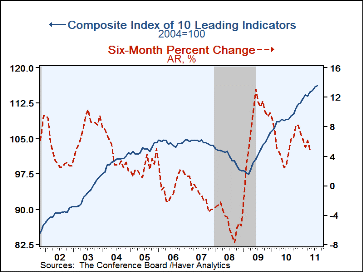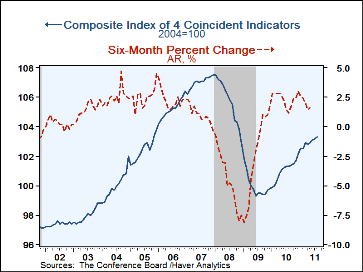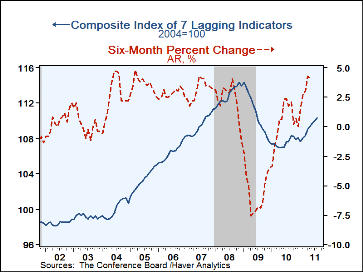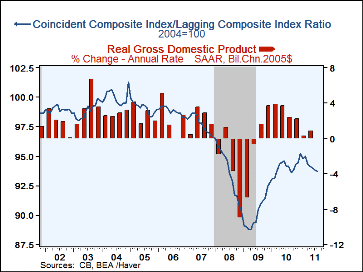 Global| Sep 23 2011
Global| Sep 23 2011U.S. Leading Indicators Continue Upward But Momentum Slows
by:Tom Moeller
|in:Economy in Brief
Summary
The Conference Board reported that its Leading Economic Indicators index rose 0.3% during August following July's revised 0.6% increase, initially set at 0.5%. The gain beat the Consensus forecast for a 0.1% rise. Despite the [...]
The Conference Board reported that its Leading Economic Indicators index rose 0.3% during August following July's revised 0.6% increase, initially set at 0.5%. The gain beat the Consensus forecast for a 0.1% rise. Despite the increase, however, the latest six-month growth rate as calculated by the Conference Board fell to 4.8%, the slowest since last August.
In conjunction with slower growth, the breadth of increase amongst the component series fell. The 1-month diffusion index dropped to 40%, its least since during the recession, and the 6-month diffusion index also eased to a low 55%. Money supply growth together with a steeper yield curve added 0.9 percentage points to the leader's August gain. Lower stock prices & consumer expectations as well as a shorter workweek offset the bulk of these positive influences.
The index of coincident indicators ticked up just 0.1%, the same as during July which was revised down from 0.3%. The 1-month diffusion index held up at 88% as did the 6-month index at 100%, but the six-month growth rate fell to 1.6%, its least since Q3 last year. Three of the component series rose last month but employment was unchanged.
In a sign that economic excesses built up, the August lagging indicator index rose 0.3% for the third straight month. Growth in bank lending to commercial and industrial customers accounted again for most of the increase. The ratio of coincident-to-lagging indicators, which tends to "lead" the "leaders," fell for the sixth month in the last seven.
Fragmentary items available thus far in September paint a picture that is not promising for another advance in the leading index. As seen yesterday, unemployment insurance claims moved up to 444,000, stock prices fell sharply, the yield curve flattened and the Univ. of Michigan Index of Consumer Expectations slipped. Offsetting these declines was the money supply which continues higher.
The Conference Board figures are available in Haver's BCI database; the components are available there, and most are also in USECON. The forecast figure is the Consensus in the AS1REPNA database. Visit the Conference Board's site for coverage of leading indicator series from around the world.
The Mortgage Market in 2010: Highlights from the Data Reported under the Home Mortgage Disclosure Act from the Federal Reserve Board can be found here
| Business Cycle Indicators(%) | Aug | Jul | Jun | Y/Y | 2010 | 2009 | 2008 |
|---|---|---|---|---|---|---|---|
| Leading | 0.3 | 0.6 | 0.3 | 6.5 | 7.8 | 0.3 | -3.1 |
| Coincident | 0.1 | 0.1 | 0.2 | 2.0 | 1.1 | -5.4 | -1.3 |
| Lagging | 0.3 | 0.3 | 0.3 | 2.4 | -2.9 | -1.9 | 3.1 |
Tom Moeller
AuthorMore in Author Profile »Prior to joining Haver Analytics in 2000, Mr. Moeller worked as the Economist at Chancellor Capital Management from 1985 to 1999. There, he developed comprehensive economic forecasts and interpreted economic data for equity and fixed income portfolio managers. Also at Chancellor, Mr. Moeller worked as an equity analyst and was responsible for researching and rating companies in the economically sensitive automobile and housing industries for investment in Chancellor’s equity portfolio. Prior to joining Chancellor, Mr. Moeller was an Economist at Citibank from 1979 to 1984. He also analyzed pricing behavior in the metals industry for the Council on Wage and Price Stability in Washington, D.C. In 1999, Mr. Moeller received the award for most accurate forecast from the Forecasters' Club of New York. From 1990 to 1992 he was President of the New York Association for Business Economists. Mr. Moeller earned an M.B.A. in Finance from Fordham University, where he graduated in 1987. He holds a Bachelor of Arts in Economics from George Washington University.










